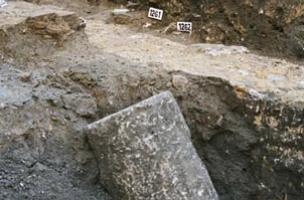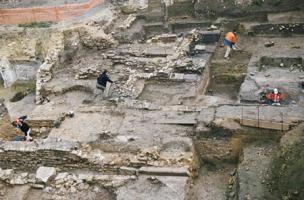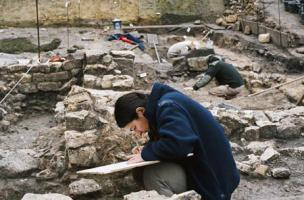Search
You are here
Vanves reveals its Roman and mediaeval past
A team from the Institut national de recherches archéologiques preventives (Inrap) has found important Gallo-Roman and Mediaeval remains in the town of Vanves. A preventive excavation, curated by the State, is being carried out prior to the construction of a residential building.
Chronicle of site
Post date
20 December 2005
Last modified
13 February 2017
In 1999, a substantial Gallo-Roman bath-house was excavated on an adjoining plot of land. At that time only part of the construction was visible. The complete plan and the exact dimensions of the baths have still to be discovered.
Today, a vast peripheral gallery, which can be dated to the 2nd or 3rd century AD, is being excavated. This gallery encloses a space whose nature is as yet unknown: simple courtyard or public square? In late Antiquity, a group of modest dwellings were installed here. During the Merovingian and Carolingian periods, the site was taken over by craftsmen. For example there are four highly interesting Early medieval potter's kilns on the site.
The results of the Rue Gaudray excavation will help to characterise Roman Vanves: villa, vicus (quarter or district) or suburban sanctuary of Lutetia…
Not so long ago, the earliest information known about Vanves came from a late 10th century document, the charter of King Robert the Pious, which mentions a few acres of vineyards at Venva. Excavation has revealed the town's Roman origins, a thousand years earlier.
Today, a vast peripheral gallery, which can be dated to the 2nd or 3rd century AD, is being excavated. This gallery encloses a space whose nature is as yet unknown: simple courtyard or public square? In late Antiquity, a group of modest dwellings were installed here. During the Merovingian and Carolingian periods, the site was taken over by craftsmen. For example there are four highly interesting Early medieval potter's kilns on the site.
The results of the Rue Gaudray excavation will help to characterise Roman Vanves: villa, vicus (quarter or district) or suburban sanctuary of Lutetia…
Not so long ago, the earliest information known about Vanves came from a late 10th century document, the charter of King Robert the Pious, which mentions a few acres of vineyards at Venva. Excavation has revealed the town's Roman origins, a thousand years earlier.

Pièce d'habitation rue Gaudray
© G. Pollin, Inrap

Fût de colonne rejeté dans une fosse datée du IIIe siècle après Jésus-Christ
© G. Pollin, Inrap

Vue d'ensemble des vestiges antiques et médiévaux
© G. Pollin, Inrap

Relevé des vestiges gallo-romains
© G. Pollin, Inrap
Site Director : Xavier Peixoto, Inrap
Curation : Regional archaeology service (Drac Île-de-France)
Developers : RD Promotion - Vinci Immobilier
Contact(s) :
Mahaut Tyrrell
Media communication
Inrap, media partnerships and relations
+33 6 07 40 59 77
mahaut.tyrrell [at] inrap.fr

